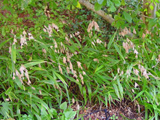Native Plants

Q. Who is Mr. Smarty Plants?
A: There are those who suspect Wildflower Center volunteers are the culpable and capable culprits. Yet, others think staff members play some, albeit small, role. You can torture us with your plant questions, but we will never reveal the Green Guru's secret identity.
Did you know you can access the Native Plant Information Network with your web-enabled smartphone?
Ask Mr. Smarty Plants is a free service provided by the staff and volunteers at the Lady Bird Johnson Wildflower Center.

rate this answer
Sunday - June 21, 2009
From: Covington, LA
Region: Southeast
Topic: Grasses or Grass-like
Title: Native grasses for wildlife in Katrina recovery area of Louisiana
Answered by: Nan Hampton
QUESTION:
I live in La in an area decimated by Katrina and want to establish 11 acres of wildlife friendly native short grasses. It is partly designated wetlands because it floods, but also has long periods without much water, and of course, there are not many trees yet. What are the best selections? Thank you.ANSWER:
Mr. Smarty Plants commends you on your project! You can actually search for these yourself by doing a COMBINATION SEARCH on our Native Plant Database by selecting Louisiana from the Select State or Province and 'Grass/Grass-like' from Habit (general appearance) and 'Wet - soil is saturated with water' from Soil moisture. This will give you more than 40 choices. it is possible that for some of your area you can use grasses that live in moist soil. If you add that choice to your search, you will get more than 70 choices. Of course, not all of those are going to be short grasses or necessarily wildlife friendly, so I'm going to recommend several that I think should do well for you. I'm going to include some tall bunchgrasses for you to consider as well because of their attractiveness and suitability for wildlife.SHORTER GRASSES AND GRASS-LIKE PLANTS
Andropogon glomeratus (bushy bluestem) is a very attractive grass in all seasons that does well in wet areas and is larval host for several butterflies.
Bouteloua curtipendula (sideoats grama) provides food for birds and butterflies. It would do well out of the flooded areas in moist soils.
Carex stipata (owlfruit sedge) grows well in wet soils in the sun and is an important food for the swamp sparrow.
Carex texensis (Texas sedge) grows to less than 1 foot tall in sun and part shade in moist areas.
Carex vulpinoidea (fox sedge) grows in wet or moist soil in the sun and attracts birds.
Chasmanthium latifolium (Inland sea oats) is an attractive grass that is larval host to several butterflies and its seeds are used by birds and other wildlife. It does best in part shade or shade.
Eleocharis montevidensis (sand spikerush) grows well in low wet areas in full sun and is food for waterfowl and shorebirds.
Eragrostis spectabilis (purple lovegrass) grows in moist soils in full sun to less than 2 feet and provides nesting cover for birds.
Poa arachnifera (Texas bluegrass) grows to less than 2 feet in moist soils in sun or part shade. Seeds provide food for birds and small mammals. Also, it attracts butterflies.
TALLER GRASSES
Andropogon gerardii (big bluestem) can withstand periodic flooding as well as drought conditions. It provides food and shelter for more than 20 bird species and is a larval host to several butterflies and moths.
Panicum virgatum (switchgrass) grows in moist soils in the sun and part shade and is larval host and nectar source for several butterflies.
Sorghastrum nutans (Indiangrass) is an attractive tall grass with seeds that provide food for small mammals and birds and also attracts butterflies.
Spartina alterniflora (smooth cordgrass) can grow in moist or wet brackish to very salty soils but is not drought tolerant. Its seeds are eaten by a variety of birds.
Tripsacum dactyloides (eastern gamagrass) has attractive flower heads and its seeds are eaten by deer and birds.
You also might find some or all of the articles under "Large Scale Wildflower Planting" in our How-to Articles useful to your project.
More Grasses or Grass-like Questions
Ground cover to control hillside erosion in Illinois
May 04, 2014 - I have seen some other questions regarding native plants for erosion control, but I am looking specifically for plants that will do well on a hill in partial to full shade. I am told the soil in our a...
view the full question and answer
When to stop mowing Habiturf for seeding from Austin
November 14, 2012 - I planted a native Habiturf lawn in my back yard last spring/summer and it is doing very well. The how-to mentions allowing the turf to seed out once per year to help maintain the lawn. Is there a bes...
view the full question and answer
Plants to stop erosion on creek side
July 05, 2011 - I need plants for a westside slope to a creek that will help with erosion, need fast growing and likes lots of sun. Thank you,
Mr. Smarty Plants
view the full question and answer
Native plants for sandy soil and not much water
April 14, 2008 - I am planning a new garden at home and would like to grow native plants that can handle sandy soil and don't need much water. I do not water my gardens.I would prefer plants that can have more than o...
view the full question and answer
Planting grass seed in Greenville SC
April 24, 2009 - What type of grass seed is best to use in a sunny/ shady area where some grass is already growing? And how is the best way to prep the area for seed and fertilizer or what should I do before and after...
view the full question and answer
| Support the Wildflower Center by Donating Online or Becoming a Member today. |

